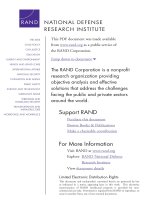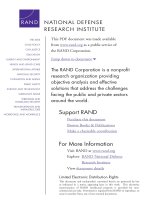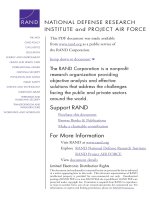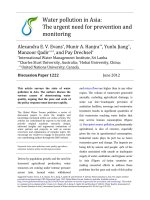The High Cost of High School Dropouts: What the Nation Pays for Inadequate High Schools ppt
Bạn đang xem bản rút gọn của tài liệu. Xem và tải ngay bản đầy đủ của tài liệu tại đây (639.33 KB, 6 trang )
The High Cost of High School Dropouts:
What the Nation Pays for Inadequate High Schools
Every school day, nearly 7,000 students become dropouts. Annually, that adds up to about 1.2 million
students who will not graduate from high school with their peers as scheduled.
1
Lacking a high school
diploma, these individuals will be far more likely than graduates to spend their lives periodically
unemployed, on government assistance, or cycling in and out of the prison system.
Most high school dropouts see the result of their decision to leave school very clearly in the slimness
of their wallets. The average annual income for a high school dropout in 2009 was $19,540, compared
to $27,380 for a high school graduate, a difference of $7,840.
2
The impact on the country’s economy is
less visible, but cumulatively its effect is staggering.
If the nation’s secondary schools
improved sufficiently to
graduate all of their students,
rather than the 72 percent of
students who currently graduate
annually,
3
the payoff would be
significant. For instance, if the
students who dropped out of
the Class of 2011 had
graduated, the nation’s
economy would likely benefit
from nearly $154 billion in
additional income over the
course of their lifetimes.
Everyone benefits from increased graduation rates. The graduates themselves, on average, will earn
higher wages and enjoy more comfortable and secure lifestyles. At the same time, the nation benefits
from their increased purchasing power, collects higher tax receipts, and sees higher levels of worker
productivity.
Economic Recession More Likely to Impact High School Dropouts
Not only do employed high school dropouts earn less than employed high school graduates, high
school dropouts are much more likely to be unemployed during economic downturns. Since the
economic recession began in December 2007, the national unemployment rate has gone from 5 percent
to 9.1 percent in August 2011.
4
Source: U.S. Department of Education, 2011
November 2011
2
As shown in the graph below, the unemployment rate for individuals of all education levels has
skyrocketed since December 2007, but high school dropouts have faced the most difficulty with
finding a job. According to data from the U.S. Bureau of Labor Statistics, the unemployment rate for
high school dropouts in August 2011—four years after the start of the recession—was 14.3 percent,
compared to 9.6 percent for high school graduates, 8.2 percent for individuals with some college
credits or an associate’s degree, and 4.3 percent for individuals with a bachelor’s degree or higher.
5
Students Who Learn More Earn More
Recent research conducted by the Alliance for Excellent Education in partnership with Economic
Modeling Specialists, Inc., an Idaho-based economic modeling firm, provides a look at the additional
earnings an individual would likely expect over the course of his or her lifetime by completing high
school. This analysis is based upon state-specific economic data that reflects the postrecession
economic reality.
The calculations beginning on page five show the monetary benefits each state would likely accrue
over the lifetimes of just one year’s worth of dropouts if those students had graduated. Calculations are
based on the number of dropouts and average earnings by education level, which causes the numbers
to vary from state to state: Vermont (at the low end) would likely see its economy increase by $147
million; Massachusetts (near the middle) would likely add $2 billion to its economy, and California’s
economy (at the high end) would likely accrue an additional $21 billion over the lifetimes of just one
year’s worth of dropouts if those students had graduated. These figures are conservative and do not
take into account the added economic growth generated from each new dollar put into the economy.
a
All told, these additional earnings from a single high school class would likely pour a total of $154
billion into the national economy. Unless high schools are able to graduate their students at higher
rates, nearly 12 million students will likely drop out over the next decade, resulting in a loss to the
nation of $1.5 trillion.
a
To see projections on additional economic benefits that each state would likely see as a result of increasing the high school graduation
rate, visit
Source: U.S. Department of Labor, Bureau of Labor Statistics, 2011
3
Who Does Not Graduate From High School?
About 42 percent of Hispanic students, 43 percent of African American, and 46 percent of American Indian students
will not graduate on time with a regular diploma, compared to 17 percent of Asian students and 22 percent of white
students.
a
Among all races and ethnicities, males graduate at a lower rate than their female peers do—68 percent versus 75
percent.
a
Graduation rates are significantly lower in districts with higher percentages of students who are eligible for free or
reduced-price lunches (a measure of poverty).
b
High school students of low-income families drop out of high school at six times the rate of their peers from high-
income families.
c
The lowest-achieving 25 percent of students are twenty times more likely to drop out of high school, compared to
students in the highest-achievement quartile.
d
a
Editorial Projects in Education, “Diplomas Count 2011: Beyond High School, Before Baccalaureate,” Education Week 30, no. 34 (2011).
b
C. Swanson, Who Graduates? Who Doesn’t? A Statistical Portrait of Public High School Graduation, Class of 2001 (Washington, DC: Urban Institute, Education
Policy Center, 2004).
c
U.S. Department of Education, National Center for Education Statistics, The Digest of Education Statistics 2010 (NCES 2011-015) (Washington, DC: U.S.
Government Printing Office, 2011), Table 116, p. 181.
d
A. P. Carnevale, Help Wanted … College Required (Washington, DC: Educational Testing Service, Office for Public Leadership, 2001).
More High School Graduates Benefit Society
Obviously, dropouts are a drain on the nation’s economy and the economies of each state. Lower local,
state, and national tax revenues are the most obvious consequence of higher dropout rates; even when
dropouts are employed, they earn significantly lower wages than do graduates. State and local
economies suffer further when they have less-educated populaces, as they find it more difficult to
attract new business investment. Simultaneously, these entities must spend more on social programs
when their populations have lower educational levels.
The nation’s economy and competitive standing also suffer when there are high dropout rates. Among
developed countries, the United States ranks twenty-first in high school graduation rates and fifteenth
in college attainment rates among twenty-five- to thirty-four-year-olds.
6
Dropouts represent a
tremendous loss of human potential and productivity, and they significantly reduce the nation’s ability
to compete in an increasingly global economy. Furthermore, recent estimates project that the future
domestic workforce demands will require higher levels of education among U.S. workers. However,
without significant improvements in the high school and postsecondary completion rates, the nation is
on track to fall short by up to 3 million postsecondary degrees by 2018.
7
High school graduates, on the other hand, provide both economic and social benefits to society. In
addition to earning higher wages—resulting in corresponding benefits to local, state, and national
economic conditions—high school graduates live longer,
8
are less likely to be teen parents,
9
and are
more likely to raise healthier, better-educated children. In fact, children of parents who graduate from
high school are far more likely to graduate from high school, compared to children of parents without
high school degrees.
10
High school graduates are also less likely to commit crimes,
11
rely on
government health care,
12
or use other public services such as food stamps or housing assistance.
13
Additionally, high school graduates engage in civic activity, including voting and volunteering in their
communities, and at higher levels.
14
4
Reducing Dropouts by Improving High Schools
To increase the number of students who graduate from high school, the nation’s secondary schools
must address the reasons why most students drop out. In a recent survey of high school dropouts,
respondents indicated that they felt alienated at school and that no one noticed if they failed to show up
for class. High school dropouts also complained that school did not reflect real-world challenges. More
than half of the respondents said that the major reason for dropping out of high school was that they
felt their classes were uninteresting and irrelevant.
15
Others leave because they are not doing well academically. According to the 2009 National
Assessment of Educational Progress in reading, only about 30 percent of entering high school
freshmen read proficiently,
16
which generally means that as the material in their textbooks becomes
more challenging, they drop even further behind.
The nation can no longer afford to have more than one-quarter of its students leave high school without
a diploma. High schools must be improved to give all students the excellent education that will prepare
them for college and a career, and to be productive members of society.
For more information about the state of America’s high schools, and to find out what individuals
and organizations can do to support effective reform at the local, state, and federal levels, visit
the Alliance for Excellent Education’s website at www.all4ed.org.
What Are the Benefits of Increasing the High School Graduation Rate?
Researchers have examined various annual and lifetime benefits associated with improved high school graduation
rates.
Compared to a high school dropout, a single high school graduate yields a public benefit of over $200,000 more in
lower government spending and higher tax revenues. If the number of dropouts were cut in half, the government
would likely see a total of $45 billion in savings and additional revenue.
a
If the male graduation rate were increased by only 5 percent, the nation would see an annual savings of $4.9
billion in crime-related costs.
b
Cutting the dropout rate of a single high school class in half would likely support as many as 54,000 new jobs and
would likely increase the gross domestic product by as much as $9.6 billion.
c
a
H. Levin, et al., “The Costs and Benefits of an Excellent Education for All of America’s Children” (New York, NY: Center for Cost-Benefit Studies of Education
Teachers College, Columbia University, 2007).
b
Alliance for Excellent Education, “Saving Futures, Saving Dollars: The Impact of Education on Crime Reduction and Earnings” (Washington, DC: Author,
2006).
c
Alliance for Excellent Education, “Education and the Economy: Boosting the Nation’s Economy by Improving High School Graduation Rates” (Washington,
DC: Author, 2011).
5
Estimated Additional Lifetime Income If High School Dropouts
Had Graduated With Their Class in 2011
State
Estimated
Graduation Rate
(SY 2007–08)
1
Projected Number of
Nongraduates for
Class of 2011
1
Total Additional Lifetime
Income If Dropouts
Had Graduated
2
Alabama
64.8%
23,007
$2,548,000,000
Alaska
66.3%
3,584
$742,000,000
Arizona
67.0%
25,632
$3,064,000,000
Arkansas
69.7%
11,405
$974,000,000
California
73.0%
139,421
$20,782,000,000
Colorado
73.3%
16,833
$2,918,000,000
Connecticut
79.2%
9,094
$1,395,000,000
Delaware
67.6%
3,475
$483,000,000
District of Columbia
43.0%
2,372
$388,000,000
Florida
63.9%
83,516
$9,478,000,000
Georgia
58.8%
60,580
$7,806,000,000
Hawaii
65.8%
5,523
$597,000,000
Idaho
75.6%
5,192
$540,000,000
Illinois
78.8%
37,491
$4,913,000,000
Indiana
72.8%
22,742
$2,920,000,000
Iowa
79.6%
7,933
$968,000,000
Kansas
75.8%
9,062
$953,000,000
Kentucky
72.8%
15,482
$2,117,000,000
Louisiana
59.6%
21,744
$3,251,000,000
Maine
76.5%
3,479
$428,000,000
Maryland
76.8%
17,697
$3,055,000,000
Massachusetts
77.5%
13,388
$2,015,000,000
Michigan
73.6%
37,721
$5,076,000,000
Minnesota
78.0%
14,311
$2,043,000,000
Mississippi
61.4%
16,102
$1,624,000,000
Missouri
76.9%
17,962
$2,319,000,000
Montana
75.8%
2,925
$312,000,000
Nebraska
77.3%
5,391
$468,000,000
Nevada
44.3%
22,359
$2,235,000,000
New Hampshire
78.2%
3,808
$372,000,000
New Jersey
86.9%
13,987
$2,592,000,000
New Mexico
57.1%
12,760
$1,289,000,000
New York
71.8%
67,922
$9,774,000,000
North Carolina
72.8%
34,168
$4,404,000,000
North Dakota
80.2%
1,593
$205,000,000
Ohio
74.3%
39,366
$4,802,000,000
Oklahoma
70.0%
14,727
$1,676,000,000
Oregon
72.6%
12,187
$1,390,000,000
Pennsylvania
77.7%
33,373
$4,089,000,000
Rhode Island
69.7%
3,601
$501,000,000
South Carolina
58.6%
27,209
$3,409,000,000
South Dakota
78.7%
2,228
$259,000,000
Tennessee
76.9%
18,195
$2,249,000,000
Texas
66.6%
129,339
$18,071,000,000
Utah
71.9%
10,511
$1,264,000,000
Vermont
82.7%
1,227
$147,000,000
Virginia
72.7%
29,251
$3,990,000,000
Washington
65.6%
30,592
$4,844,000,000
West Virginia
71.7%
6,727
$659,000,000
Wisconsin
81.3%
13,746
$1,756,000,000
Wyoming
71.3%
2,032
$159,000,000
United States
71.7%
1,154,132
$154,313,000,000
6
1
Editorial Projects in Education, ―Diplomas Count 2011: Beyond High School, Before Baccalaureate,‖ special issue, Education Week 30,
no. 34 (2011).
2
The Alliance for Excellent Education estimated the additional lifetime income if one class of dropouts were to graduate by using an
economic input-output model created by Economic Modeling Specialists, Inc. These rounded findings are based on state-level data
demonstrating the difference in average annual earnings between individuals without a high school diploma and those who hold high
school diploma as their highest education attainment level. Assumptions include a one percent earnings growth rate, a four percent
discount rate, and a 45 year working life. The national figure is the sum of that for each state. These figures represent a change in
methodology from previous iterations; average earnings differences are now state-specific and assumptions have been modified to reflect
the current economic reality.
Endnotes
1
Editorial Projects in Education, ―Diplomas Count 2011: Beyond High School, Before Baccalaureate,‖ special issue, Education Week 30,
no. 34 (2011).
2
T. D. Snyder and S. A. Dillow, Digest of Education Statistics 2010 (2011-015), (Washington, DC: U.S. Department of Education,
National Center for Education Statistics, Institute of Education Sciences, 2011).
3
Editorial Projects in Education, ―Diplomas Count 2011.‖
4
U.S. Department of Labor, Bureau of Labor Statistics, ―Labor Force Statistics from the Current Population Survey,‖
(accessed September 7, 2011).
5
Ibid.
6
Organisation for Economic Co-operation and Development, Education at a Glance 2008 (Paris: Author, 2008).
7
A. P. Carnevale, N. Smith, and J. Strohl, Help Wanted: Projections of Jobs and Education Requirements Through 2018 (Washington,
DC: Georgetown University Center on Education and the Workforce, 2010).
8
P. Muennig, ―Health Returns to Education Interventions,‖ paper prepared for the symposium Social Costs of Inadequate Education,
October 24–25, 2005, Teachers College, Columbia University, New York, NY.
9
R. Haveman, B. Wolfe, and K. Wilson, ―Childhood Events and Circumstances Influencing High School Completion,‖ Demography 28,
no. 1 (2001).
10
B. L. Wolfe and R. H. Haveman, ―Social and Non-market Benefits from Education in an Advanced Economy,‖ paper prepared for
Conference Series 47, Education in the 21st Century: Meeting the Challenges of a Changing World, June 2002, Federal Reserve Bank
of Boston, Boston, MA.
11
S. Raphael, ―The Socioeconomic Status of Black Males: The Increasing Importance of Incarceration‖ (Berkley, CA: Goldman School
of Public Policy, University of California, 2004).
12
Muennig, ―Health Returns to Education Interventions.‖
13
I. Garfinkel, B. Kelly, and J. Waldfogel, ―Public Assistance Programs: How Much Could be Saved with Improved Education?,‖ paper
prepared for the symposium Social Costs of Inadequate Education, October 24–25, 2005, Teachers College, Columbia University,
New York, NY.
14
J. Junn, ―The Political Costs of Unequal Education,‖ paper prepared for the symposium Social Costs of Inadequate Education, October
24–25, 2005, Teachers College, Columbia University, New York, NY.
15
J. Bridgeland and J. di Iulio, The Silent Epidemic: Perspectives of High School Dropouts (Washington, DC: Civic Enterprises, 2006).
16
U.S. Department of Education, National Center for Education Statistics, The Nation’s Report Card: Reading 2009 (NCES 2010–458)
(Washington, DC: U.S. Government Printing Office, 2009).
The Alliance for Excellent Education is grateful to MetLife Foundation for providing generous support
to develop the first edition of this brief in January 2007. The findings and conclusions presented are
those of the Alliance and do not necessarily represent the views of the funder.









